COVID-19: MN Governor Walz Announces New Measures
Governor Walz to Announce Next Steps in State’s Response to COVID-19
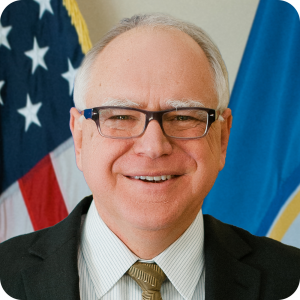
Read the 11-6-2020 COVID-19 Update from the Minnesota Department of Health Here
After Minnesota hit a fourth consecutive day of setting a new record for new COVID-19 cases, Governor Tim Walz briefed the media on the next steps in the state’s response to COVID-19. There are now more than 170,000 confirmed cases in Minnesota.
This is a summary of the governor’s media briefing:
- We’ve worked hard to control the rate of infection and to protect our frontline workers
- We have to be candid in MN. We are in the midst of a significant surge in coronavirus cases
- This was not unexpected
- New cases are increasing more quickly than ever
- “unrelenting, broad community spread… will require aggressive mitigation to avoid additional increases in cases, hospitalizations and deaths.”
- Source: White House Coronavirus Task Force
- Almost daily records for new case growth and hospitalizations last week, and that trend continues
- The fast case growth is not limited to one part of the state
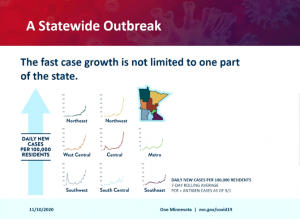
- This is not a situation where we’re panicked, but our ability to deal with this could change very quickly
- What we’re seeing now is where Arizona was around the 4th of July
- Just ten days ago MN was 21st in infection rates. We will quickly join the group of our surrounding states if we don’t make decisions to mitigate that.
- Hospital Capacity at Risk
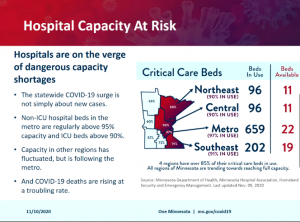
- The statewide COVID-19 surge not simply about new cases
- Non-ICU hospital beds in the metro are regularly above 95% capacity and ICU beds above 90%
- Capacity in other regions has fluctuated, but is following the metro
- And COVID-19 death rates are rising at a troubling rate
- We’re running out of personnel because they’re also getting COVID
- How do we respond?
- We follow the best advice of the public health heroes serving our state
- Our response balances controlling the spread of COVID-19, the economy, and thew personal well-being of all Minnesotans
- Each person has a role to play
- There’s ways we can reduce the risk, but not eliminate it
- If we want to slow the spread of COVID, we’re gonna have to take ownership of this and bend this curve through proven practices that make a difference
- How is COVID-19 spreading?
- We are seeing spread in every part of daily life and in all types of settings
- But our growing understanding of ways this virus spreads allows us to be more surgical in our response
- This outbreak is not caused by one or two big events
- The data tells us about the who, where, and when that plays a significant role in driving the spread
- Who?
- Younger adults have disproportionate share of new cases
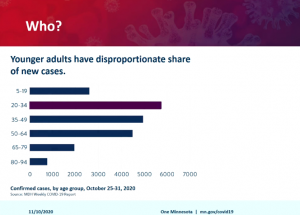
- Where and when?
- Social settings are driving much of the new COVID-19 spread in the state
- Private social gatherings
- Weddings, funerals, private parties and other group settings
- Late night outings in bars and restaurants
- Social settings are driving much of the new COVID-19 spread in the state
- Source of recent COVID-19 Outbreaks
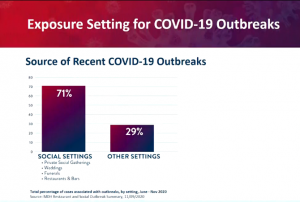
- What makes it risky?
- Gatherings of friends and loved-ones who are comfortable with each other and live in different households
- Eating and drinking without face coverings over extended periods of time
- Loud settings that increase respiratory droplets in the air as people talk, laugh, or sing.
- Get-togethers that involve alcohol, which lower inhibitions and interfere with social distancing, especially as the night wears on.
- Stay Safe Plan Updates:
- Social Gatherings
- 10 person limit for indoor and outdoor gatherings
- Three households or less, including the host
- Effective 10 p.m., Friday, Nov. 13
- Receptions and Similar Events
- Phased in approach to attendance limitations
- Nov. 27: 50 person limit
- Dec. 11: 25 person limit
- The events may not take place between 10 p.m. to 4 a.m.
- No change to the actual wedding, funeral or similar planned ceremony — only the connected reception, celebration, or similar gathering.
- Phased in approach to attendance limitations
- Bars and Restaurants
- Indoor/Outdoor: 50% of capacity, but no more than 150 people total
- Counter closed for seating and service, unless counter-only service establishment
- Patrons must be seated at tables and no bar games that require standing permitted
- No dine-in service 10 p.m. to 4 a.m. May remain open for delivery and take out
- Effective: 10 p.m., Friday, Nov. 13
- Social Gatherings
- I recognize this is painful, this is no fun
- Small Business Support
- Businesses are struggling as they combat the spread of COVID-19
- Proposing $10 million in additional funding to businesses that have already applied for relief
- This will help 1,000 more businesses pay bills and pay workers
- Bridge to Better Times
- We will take strong steps to target the riskiest areas and slow the spread of COVID-19
- We cannot regulate away all risk
- But we manage risk until the day our brightest minds develop the tools to end this pandemic
- For now, everyone must:
- wear a mask
- keep some space from others while you’re out
- avoid large crowds
- And get a test — it’s easier than ever to find out your status and isolate if you’re positive
- We will take strong steps to target the riskiest areas and slow the spread of COVID-19
Update from Dr. George Morris from CentraCare
- We’re getting hit hard right now
- We’re seeing the numbers go up, we’re seeing the surges happen. We’re seeing it hit us, and we’re seeing those patients in our facilities
- In St. Cloud Hospital, we’re seeing about one-third of all of our in-patients are COVID or related to COVID illnesses. This is an astronomical number. And we know that number continues to grow as we see the virus spread throughout our communities.
- Of those in-patients, about a third of them are requiring critical care
- We have patients in the hospital in their 20s, 30s, and 40s, and we’re seeing them suffer severe illness due to COVID
- We’re also seeing, as the virus spreads quickly in our communities, the key aspects of testing, tracing and answering the phone call and being aware of your surroundings are what will help us mitigate risks and decrease the spread of this virus
- In essence, we are still providing care for the routine medical needs. While we’re not adding the COVID-related illnesses, we are seeing the effects on our staff
- We do see concerns with fatigue
- We’re seeing our staff struggle with their own illnesses and concern for their own safety
- We have them available now, and we want to continue to keep them available because we haven’t even hit the peak yet.
- In the meantime, wear your mask, wear it properly. Do social distancing indoors and outdoors. Maintain the social connection. Wash your hands. Minimize social gatherings. Stay home if you’re ill. And let people know how you’re feeling.
- This is our time as a whole state to come together and tackle this virus.
Dr. Marc Gorelick, President and CEO of Children’s Minnesota
- We are facing dramatic increase in cases of COVID-19, including in hospitalized patients
- Today we set a record at Children’s MN. We have 13 kids in the hospital, including five children in intensive care. That’s the most we’ve had since the pandemic started.
- Early on our main challenge was around supply shortages. But now our main challenge is around staffing.
- While we have extensive measures in place to prevent exposure to COVID-19 for our staff within our walls, they are part of our community, and they are therefore at-risk for community spread just like the rest of us.
- Today we have over 200 of our staff who are out. The vast majority because of COVID exposure in the community.
- We have systems in place to manage hospital capacity.
- By and large, the system has been working well for us. But we’re at the point now where we actually need to take steps to increase that capacity, not just manage it.
- Wear a mask. Wash your hands. Watch your distance. And limit opportunities for exposure in group settings. Especially indoors.
- We also have to take steps to enforce that.
- If you haven’t gotten a flu shot, get a flu shot
- If you support our health care heroes and want to show it, do everything you can to keep them healthy and safe out in the community.
DEED Commissioner Steve Grove
- This has never been about public health versus the economy. We can’t really begin economic recovery in a full sense until we get this pandemic under control.
- We believe by taking targeted action today, we have a shot at preventing long term harm in the economy
- We’ve lost over 380,000 jobs since the pandemic began. That’s a stunning number. We have paid out over $8.5 billion in unemployment insurance payments since the pandemic began. That’s more than ten times we’ve ever paid out in a single year in unemployment benefits. That even includes the Great Recession.
- But in recent months that’s turned around. We’ve gained about half of those jobs back. Job growth is on the rise. It’s not as fast as we would like but it is positive.
- Now we’re down to about 260,000 Minnesotans who every week claim unemployment insurance benefits.
- So the trend lines have been positive
- Without the targeted steps to fight COVID, we don’t think a complete turnaround would be possible
- We talk with hundreds of thousands of businesses every week. We hold roundtables with the hospitality industry, chambers of commerce… those consultations have been critical for us to figure out what kinds of targeted steps can we make. What will work and what won’t?
- We’re trying to be as thoughtful and careful as we can to minimize economic harm while maximizing public health gain.
- Really this is about working together to keep the economy moving and thriving
- In the meantime, support small businesses and get takeout from restaurants
- We are increasing the size of our small business relief grant to an additional $10 million (that money will go to businesses who have already applied and who were selected to be on the waitlist for the lottery for those programs).
- Make no mistake, that won’t solve the problem for the challenges businesses are facing, but what will is if we all start to buckle down, follow the guidelines. Wear our masks. Wash our hands. Not only does our public health depend on it, but our local economy does too.
Walz: “Here’s the bottom line. You have control over where this thing goes. You have control over wearing of a mask, behavior, the social distancing, all of those things are the way we can get a handle of it. It is not inevitable that we end up in a crisis situation, but if we don’t do those things, we certainly will be there. And I want to thank you for the sacrifices that you’ve made. We’ve got a little while longer.”
Notes from Q & A with Media:
- The governor received a question about how the they’ll enforce the limits put on holiday gatherings. Walz said, “We’re not going in to someone’s home and arresting them on Thanksgiving.” He says it’s more about people making a “social compact” to help their neighbors.
- As far as the timing of this (taking place after the election), Walz said, “If we had this spike in August, we would have done it in August.”
- “I think when history writes the story of this it’s gonna be a pretty unforgivable sin that we allowed masks to become a political symbol or decisions that we’re going to make.”
- The virus dictates our timing. The virus dictates the moves that we make.
- Walz: The spread in retail settings is relatively limited. The virus spreads where you have large numbers of people in close contact with one another for extended periods of time. That’s unfortunately Thanksgiving dinner. Bars and restaurants. Wedding receptions.
- Walz: There’s certainly no political upside to having to tell people really bad news. I said it in the press conference over there, I’m John Lithgow in Footloose. I’m just the buzzkill on every single thing. But the fact of the matter is, these are things that save lives. That preserve hospital capacity. And the whole irony of this thing is, doing things right gets our economy back open again.
- Weddings specifically will not be impacted by the new guidelines. It’s the wedding receptions that will be impacted.
- Walz: “The Sturgis Rally was absolutely unnecessary and there’s a lot of data to show that.”
- Walz: “Do I think South Dakota should have done a mask mandate and not had the Sturgis Rally? Absolutely.”
- Walz: “Should I have done a mask mandate earlier? Yes, I think so.”
Brooklyn Center | Brooklyn Park | Champlin | Crystal | Golden Valley | Maple Grove | New Hope | Osseo | Plymouth | Robbinsdale | Rogers | Twin Cities

















